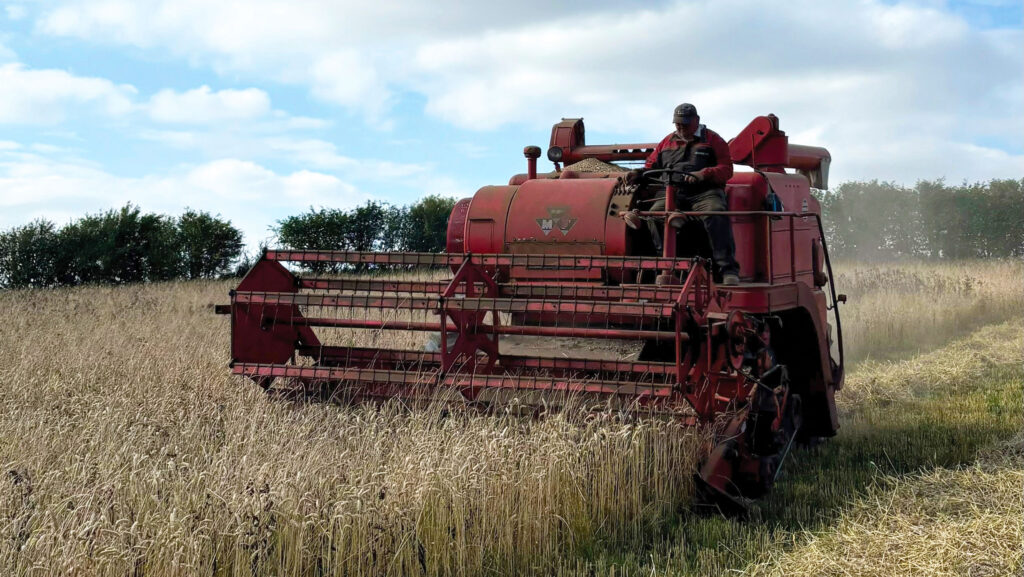Vintage combine brings in the Wildfarmed wheat harvest
 © Simon Herring
© Simon Herring A vintage 1970 Massey 515 combine was busy harvesting an organic bicrop of winter wheat and beans at Simon Herring’s Lincolnshire farm last week.
After an initial bit of tinkering to get the 54-year old machine ready for action, owner and combine operator Sean Oliver reports the crop was cutting well, with its 12ft header.
“Sean was in his element – although it was a bit of a dusty experience. It just goes to show the concept of combining has not changed in 50 years. It’s just there are more buttons and levers on modern-day equipment, and today’s machines go much faster,” says Simon.
See also: SFI 2024 changes: What they mean for arable farmers
Wheat and beans bicrop
This year marks the first time Simon trialled growing a wheat and bean mix destined for the Wildfarmed milling wheat market. The mixed farm in the Lincolnshire Wolds is currently undergoing organic conversion.
A 6.5ha trial comparing the inter-crop mix and standard winter wheat was established using a vintage Massey 30 12ft drill, which also dates back to the early 1970s.
“Crops were planted mid-October following a two-year, fertility-building herbal ley, which was grazed by our cattle,” says Simon.
“It’s been a tough test, as we’ve had so much rain over the winter. Three days after drilling, we had 100mm of rain. Parts of the field were washed away, so it’s been difficult to compare.
“The beans, however, performed well, but we think we went a bit heavy on the seed rates, so we’re going to cut it back for next year.”
Yields came in at about 2t/ha from the zero-input, organic crop. After crops were established, the farm gate was shut, letting the livestock manure, fertility building ley and N-fixing beans do the work.
Simon hopes he will achieve milling premium, and plans to increase the acreage next year to 20ha.
Why organic?
His decision to move to organic was largely driven by the farm’s beef enterprise, involving 150 head of Lincoln Red cattle which are mob-grazed and Pasture For Life accredited.
Running a low-input cattle herd, starting the organic journey was a logical move, which is why he wanted to mimic this across the arable area as well.
Half of the 400ha farm is currently under various Sustainable Farming Incentive (SFI) schemes, including herbal leys, legume mixes and wild bird feed areas.
“A couple of years ago, we took on a block of 200ha which had been intensively farmed. The SFI is providing a good break for the land, and we are being paid to do so.”
The plan is to slowly bring this land back into the arable rotation, ploughing up herbal leys and bringing it back to wheat.
“Our rotation is to plough-up herbal leys after two/three years, allow the land to chit for a few weeks and then work over with a light cultivation. We then aim to drill wheat mid to late October.”
However, establishment plans are already proving a challenge, as Simon describes soil “as rock hard and difficult to plough”, being surprisingly dry in the Lincolnshire Wolds.
Simon is keeping drilling windows as open and flexible as possible to avoid the likelihood of weather events disrupting establishment, similar to last year.
“My plan is to just look at the sky, study the weather apps and make a call – hopefully it will pay off,” he says.
What is Wildfarmed?
Wildfarmed offers a new regenerative route to market for cereal growers, which rewards farmers who reduce chemical use and promote plant diversity.
Founded in 2018 by DJ-turned-farmer Andy Cato and colleagues Edd Lees and George Lamb, a set of robust standards were set up in order for farmers to grow the Wildfarmed way.
These standards are:
- Minimise bare soil – use over crops ahead of spring crops
- Cash crops must be sown with pulses, other companions or in an annual/perennial mix
- Use a maximum of 80kg of N/ha – based on sap analysis and leaf testing
- Integrate livestock into the rotation at least once every three years
- No insecticides, fungicides or herbicides.

